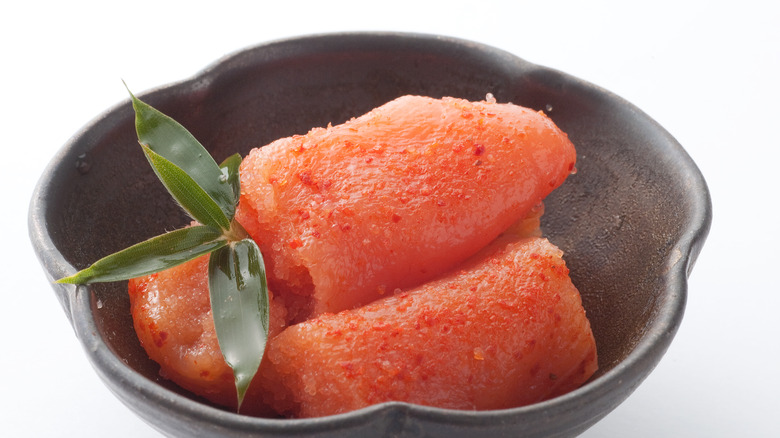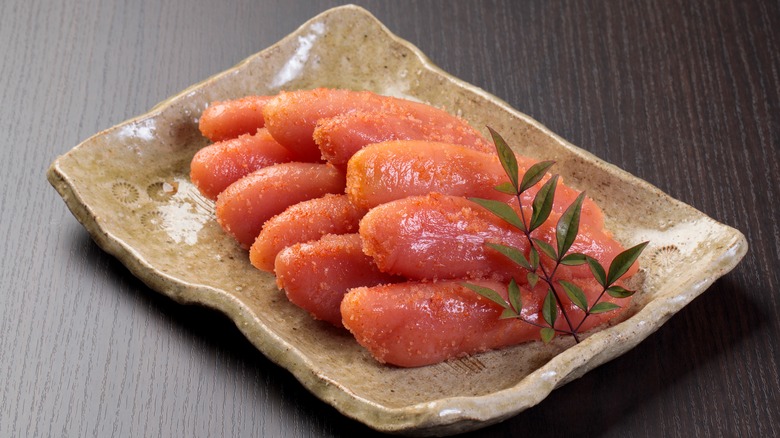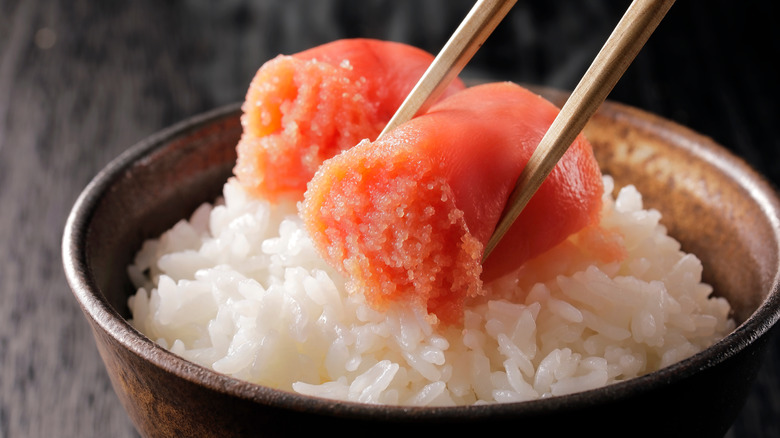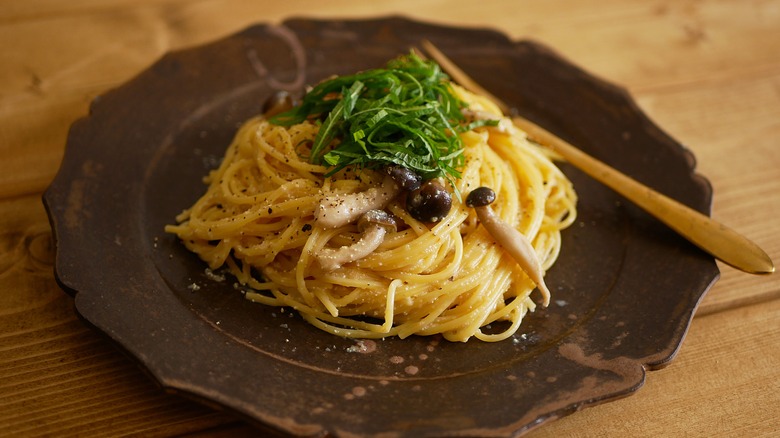Mentaiko: The Spicy Roe For People Who Don't Love The Taste Of Fish
As ironic as it may sound, we now live in a world where it is actually possible to enjoy eating fish without liking the taste of fish itself.
Alongside the popularity of sushi comes mentaiko, a spicy cod roe, often referred to as caviar's Japanese cousin (via Eater). Mentaiko (which translates to "children of the cod") was in the past only found in Japan and Korea, but has quickly turned up in many restaurants and grocery stores in the U.S. In addition to its increasing popularity due to its unique taste, like most other types of fish, mentaiko is an excellent nutritional supplement, containing calcium, vitamin B12, omega 3 fatty acids, and, of course, protein (per UIFSA). According to Fitsian Food Life, mentaiko is also a good choice for those of us who are counting calories, as it has only 15 per tablespoon.
And for those who simply don't love the taste of fish, it is of course a unique alternative.
What is it?
Mentaiko is the roe or sac of fully formed eggs from the Alaskan Pollock, which is a fish in the cod family that inhabits the north Pacific waters (via Delighted Cooking). The roe sac is separated from the fish and cured with salt and marinated in spices. Despite mentaiko being firmly rooted in Japanese cuisine, it actually originates from South Korea, dating back to the 17th century, when Korean fishermen found the fish eggs to be more delicious than the body itself (per Bokksu). It wasn't until after World War II, when a Japanese version was created in the town of Fukuoka, that mentaiko turned into a national treasure.
When it comes to eating fish eggs, people usually think of caviar; however, unlike caviar, which is roe from sturgeon found in the Black Sea, it is typically sold as an intact sac rather than loose eggs. Also it is quite a bit more affordable. For example, 4.5 ounces of Osetra caviar is expensive (over $300), while the same amount of mentaiko is only $11 (according to Eater). Often confused with tarako, which is plain and salted, mentaiko is marinated and, as a result, has a strong flavor profile and a deeper red color (via Medium).
How does it taste?
Unlike canned tuna, sardines, or anchovies, mentaiko exhibits a milder salinity profile while having a creamy texture that is comparable to uni or avocado (per Eater). It is an option worth trying for those who typically avoid fish, because it still has the seafood essence while not being overly fishy (according to The Spruce Eats). It also is an excellent source of protein.
It still packs a salty punch, but is not overwhelming like uni, and is often seasoned with a concoction of spices like chili powder, mustard, and sesame, which provides the characteristic spiciness that people love (via Rice).
According to Eater, Niki Nakayama, the owner two-Michelin-star restaurant n/naka in Los Angeles, believes it can gain the same mainstream popularity of tahini or fish sauce, "because it's not overwhelmingly fishy and it's super versatile," said Nakayama. "A lot of people mistake it for grated cheese at our restaurants."
How to use it
Due to its celebrated versatility, mentaiko can be enjoyed alone or in a wide variety of dishes like pasta, sushi, and salads. Mentaiko is even found in unexpected places, like on top of hot dogs, encased in bakery milk buns and added flavoring to Cheetos and Pringles (per Eater). Try whisking into a Caesar dressing or spreading over toast, crepes, or latkes.
For lovers of the popular Japanese snack onigiri, mentaiko is a great substitute as a filling in these little delightful rice balls (according to Slurrp). Not only found in Asian restaurants, mentaiko is a favorite item in Italian cuisine, and at Tonari, an Italian restaurant in Washington, D.C., they serve it on top of pizza. Mentaiko spaghetti is a great option for those trying it out for the first time, and it has come to be enjoyed as a late night snack in Japanese restaurants (via Bokksu).
Niki Nakayama suggests that even the staunchest fishy-food detractors will enjoy it mixed into a dip and paired with a dry white wine. Her favorite way to enjoy mentaiko is with a sidecar of white rice. "There are endless ways to utilize mentaiko. A lot of Japanese people enjoy mixing it with mayonnaise, which is a great place to start," proclaimed Nakayama in Eater.
Where to buy it
Previously you would need to travel to Fukuoka, Japan — the mentaiko capital of the world — to find the ingredient, but it is now more readily available in grocery aisles and even chain restaurants in the U.S. (per Eater). Keep an eye out for the word "karashi," which means "spicy," and is often put on mentaiko cans or packages — it's the version you want to seek out, according to Serious Eats. Surprisingly, high-end seafood distributors are even offering overnight delivery of mentaiko (via The Spruce Eats). And while it needs to be refrigerated in an airtight container once delivered, it also can be frozen for up to three months. Oceanside Seafood now sells 5-oz. packages of mentaiko, contained in three and four egg sacs, to add as a topping for ramen or as a filling and you can even order it from Amazon! You may find it as a small but significant ingredient in a wide array of dishes.




